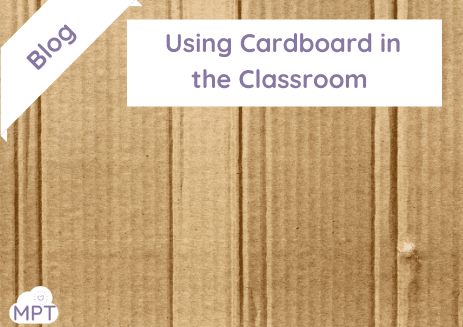Cardboard is something that we all use and something we often have an abundance of, especially after Christmas. So, why not teach the children how we can reuse the cardboard, have fun creating and also make practical things? It’s a great way to merge art and DT, while also teaching children the value of being sustainable.
The first thing you need is a glue gun!
Ideas for EYFS
Creative Cardboard Clipboards
Draw around an old clipboard on a cardboard box. Draw around it another time, on another part of the box. Cut out the two pieces of cardboard. Using a glue gun/ glue stick, seal the two cardboard pieces together and then add a foldback clip or two extra-large paper clips. This is a great activity for dexterity. You can simplify the way that the paper is attached by using Blu Tack.
Easels
Easels don’t always have to be new, plastic or expensive. In small groups, take a large cardboard box and cut out 4 x A3 pieces of cardboard. Using a glue stick, glue two pieces together and then glue the other two pieces together. On one end of both cardboard pieces, use a pencil to punch a hole in one end and then the other. Now, thread ribbon or string through the hole to make a hinge. At the bottom of the cardboard, do a similar thing but with more length to make a sort of tipi shape. As with the clipboards, use Blu Tack or extra-large paper clips to attach the paper and get painting.
Ideas for KS1
Paint Brush Pots and Pencil Pots
Talk first about the shape of pencil pots and what 2D shapes make up a cylinder. First, draw a circle around an old pencil pot. Then, draw a rectangle to make the part that attaches the two circles together. Before you put all the pieces together, decorate them! Either paint them or colour them in. Then, attach the circle to the rectangle to create a cylinder shape. You will need a glue gun to do this.
Frames
Ask children to bring in a picture of their family from the home. Now, it’s time to make a frame for it. Place the picture on some cardboard and ask the children to draw around the picture. Now, cut out a piece of cardboard that is just slightly bigger than the picture – about an inch bigger, all the way around. Then, cut another piece out that is the same size but with the inside cut out for the picture to be seen through. Time to
decorate! Have fun using natural resources to get a nature-loving feel. Glue them together, leaving one side glue-free so you can slot the picture in. Add string to dangle it from the ceiling or add a challenge to see if the children can make a stand for their frame.
Ideas for KS2
Cardboard Mazes
Children love to make mazes. First, start by cutting out the baseboard – A3 is a good size. Then, spend time designing the maze using a pencil so they can correct it and change it as they go. Then, go over the final design with a black marker. The children will then need to cut out small pieces of card that will fit on the design to create a maze. Add a wall around the outside of the maze as well. Then, have fun with a marble trying to get it to the middle of the maze. The children will need to use a glue gun for this.
Storage boxes
Storage is one thing that humans use a lot of plastic for. So, let’s work towards reducing our need for more plastic storage boxes by making our own upcycled versions. First, allow the children to decide what they’re going to make a storage box for and what size they need to make it. Allow some planning time for this. Then, get to the action and start to make it! Encourage the children to be accurate, use rulers and to ensure that all sides are equal and the same. Children need to measure out a base and four sides. Then, cut them out. Talk about strength and whether they feel just one layer is strong enough. Maybe adding another layer will give it greater strength and it will last longer? Allow the children to decide as it will be dependent on what the box will be storing. It is worth looking at other cardboard boxes, such as shoe boxes, to see how they’re created to be strong. Now, decorate the box. Finally, attach all the pieces together using a glue gun.


